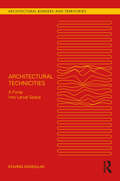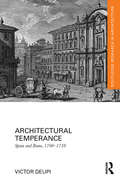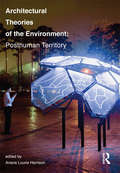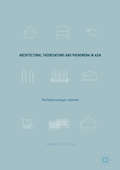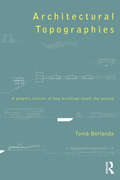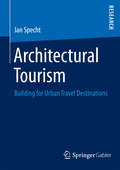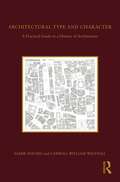- Table View
- List View
Architectural System Structures: Integrating Design Complexity in Industrialised Construction (Routledge Research in Architecture)
by Kasper Sánchez VibækThis book proposes a system structure in architectural design that conceptualises a systemic level in architecture and construction that lies between general construction techniques and specific architectural results. In order to make such a system structure operational, the elaboration of a model seeks on the one hand to analytically grasp and on the other hand to make it possible to actively work with system structures as part of architectural design. Kasper Sanchez Vibaek's ambition is to bridge an apparent and increasing gap between architectural ideation and the way these ideas are brought to life as real physical manifestations of our built environment. In line with the so-called systems sciences the book rejects the prevalent scientific view that the degree of detail ‘automatically’ enhances understanding and explanative power of complex phenomena. It establishes the idea of a systems view on buildings and architectural design that through the use of flexible constituent elements facilitates discussion and decision making about how architectural wholes are appropriately put together as assemblages of what the current and future building industry is capable of producing. Based on several years of detailed research into the architectural consequences of construction when exposed to industrialised production techniques and systems, Architectural System Structures represents a new way to look at what is already there and is useful for all those interested in the processes of architectural creation and realisation specifically attached to time, place and cultural context.
Architectural System Structures: Integrating Design Complexity in Industrialised Construction (Routledge Research in Architecture)
by Kasper Sánchez VibækThis book proposes a system structure in architectural design that conceptualises a systemic level in architecture and construction that lies between general construction techniques and specific architectural results. In order to make such a system structure operational, the elaboration of a model seeks on the one hand to analytically grasp and on the other hand to make it possible to actively work with system structures as part of architectural design. Kasper Sanchez Vibaek's ambition is to bridge an apparent and increasing gap between architectural ideation and the way these ideas are brought to life as real physical manifestations of our built environment. In line with the so-called systems sciences the book rejects the prevalent scientific view that the degree of detail ‘automatically’ enhances understanding and explanative power of complex phenomena. It establishes the idea of a systems view on buildings and architectural design that through the use of flexible constituent elements facilitates discussion and decision making about how architectural wholes are appropriately put together as assemblages of what the current and future building industry is capable of producing. Based on several years of detailed research into the architectural consequences of construction when exposed to industrialised production techniques and systems, Architectural System Structures represents a new way to look at what is already there and is useful for all those interested in the processes of architectural creation and realisation specifically attached to time, place and cultural context.
Architectural Technicities: A Foray Into Larval Space (Architectural Borders and Territories)
by Stavros KousoulasThis book poses a simple question: how is this architecture possible? To respond, it will embark on a captivating journey through many singular architectural concepts. The entasis of Doric columns, Ulysses and desert islands will outline an architectural act that moves beyond representation. A ferryman who stutters will present two different types of architectural minds. A stilus and a theory of signs will reconsider the ways architects can develop a particular kind of intuition, while architectural technicities will bring forth a membranic and territorial understanding of architecture. Finally, as a melody that sings itself, a larval architecture will be introduced, bringing space and time together. Assisting this endeavour, the thought of philosophers like Gilles Deleuze, Felix Guattari, Gilbert Simondon and Raymond Ruyer will meet the latest developments in fields like affect theory, cognitive sciences, environmental studies and neuroanthropology. Eventually, by the end of this book, the readers – from architecture students and researchers to academics and practitioners with an interest in theory – will have been exposed to a comprehensive and original philosophy of architecture and the built environment.
Architectural Technicities: A Foray Into Larval Space (Architectural Borders and Territories)
by Stavros KousoulasThis book poses a simple question: how is this architecture possible? To respond, it will embark on a captivating journey through many singular architectural concepts. The entasis of Doric columns, Ulysses and desert islands will outline an architectural act that moves beyond representation. A ferryman who stutters will present two different types of architectural minds. A stilus and a theory of signs will reconsider the ways architects can develop a particular kind of intuition, while architectural technicities will bring forth a membranic and territorial understanding of architecture. Finally, as a melody that sings itself, a larval architecture will be introduced, bringing space and time together. Assisting this endeavour, the thought of philosophers like Gilles Deleuze, Felix Guattari, Gilbert Simondon and Raymond Ruyer will meet the latest developments in fields like affect theory, cognitive sciences, environmental studies and neuroanthropology. Eventually, by the end of this book, the readers – from architecture students and researchers to academics and practitioners with an interest in theory – will have been exposed to a comprehensive and original philosophy of architecture and the built environment.
Architectural Technology: Research And Practice
by Stephen EmmittSince the publication of the first edition of Architectural Technology, in 2002, there have been significant developments in the number of courses, the profile of the discipline as well as significant changes in the Construction sector. The Second edition of Architectural Technology addresses these challenges directly. Much greater emphasis is given to the three core themes of the book - Environmental Sustainability; Innovation; and Design. An increase in the visual material included reinforces the critical role of Design, aiding students to better translate conceptual designs into built artefacts. Building upon solid teaching practice from the previous edition, Architectural Technology is now more concisely structured to take the reader through the whole life cycle of a building, emphasising sustainability and building performance. Material on digital information, building information modelling (BIM) and information communication technologies has been updated. Most chapters have been re-titled to emphasise the importance of design and make the book more accessible to a wider range of students. Chapters conclude with updated/more extensive links to further reading. Architectural Technology, 2nd Edition: Bridges the knowledge gap between design and construction Tackles the core subjects of management, technologies and design from a sustainable building angle Addresses the buildability and performance of a design from a whole life perspective Thoroughly revised and updated this undergraduate level textbook is essential for Architectural Technology courses. Students studying Architectural Engineering, Architecture, Building Surveying; and more general Construction courses, will find the material invaluable.
Architectural Technology
by Stephen EmmittSince the publication of the first edition of Architectural Technology, in 2002, there have been significant developments in the number of courses, the profile of the discipline as well as significant changes in the Construction sector. The Second edition of Architectural Technology addresses these challenges directly. Much greater emphasis is given to the three core themes of the book - Environmental Sustainability; Innovation; and Design. An increase in the visual material included reinforces the critical role of Design, aiding students to better translate conceptual designs into built artefacts. Building upon solid teaching practice from the previous edition, Architectural Technology is now more concisely structured to take the reader through the whole life cycle of a building, emphasising sustainability and building performance. Material on digital information, building information modelling (BIM) and information communication technologies has been updated. Most chapters have been re-titled to emphasise the importance of design and make the book more accessible to a wider range of students. Chapters conclude with updated/more extensive links to further reading. Architectural Technology, 2nd Edition: Bridges the knowledge gap between design and construction Tackles the core subjects of management, technologies and design from a sustainable building angle Addresses the buildability and performance of a design from a whole life perspective Thoroughly revised and updated this undergraduate level textbook is essential for Architectural Technology courses. Students studying Architectural Engineering, Architecture, Building Surveying; and more general Construction courses, will find the material invaluable.
Architectural Technology
by Stephen EmmittThis core textbook brings together for the first time the technical, legal, social and philosophical issues under the umbrella of architectural technology. Part 1 covers the influences that affect the way we build - the environmental agenda, the human factors, buildability, time and costs. Part 2 takes the reader through the life of a typical building project - from briefing, through design and assembly, to use and eventual disassembly. Part 3 tackles some of the underlying issues facing the architectural technologist - from the communication of details to technological innovation. Architectural Technolgy bridges the knowledge gap between design and construction, enabling the architectural technologist to apply their unique skill in a creative and innovative way. "As a textbook aimed at those studying for membership of BIAT this is clearly very thorough and has the recommendation of their Vice President Education. However, it can also justifiably earn its place on the bookshelf of anybody involved in the construction process as a reference and to aid an understanding of others he/she will be working with to develop an environment of which to be proud." Building Engineer, July 2002
Architectural Temperance: Spain and Rome, 1700-1759 (Routledge Research in Architecture)
by Victor DeupiArchitectural Temperance examines relations between Bourbon Spain and papal Rome (1700-1759) through the lens of cultural politics. With a focus on key Spanish architects sent to study in Rome by the Bourbon Kings, the book also discusses the establishment of a program of architectural education at the newly founded Real Academia de Bellas Artes de San Fernando in Madrid. Victor Deupi explores why a powerful nation like Spain would temper its own building traditions with the more cosmopolitan trends associated with Rome; often at the expense of its own national and regional traditions. Through the inclusion of previously unpublished documents and images that shed light on the theoretical debates which shaped eighteenth-century architecture in Rome and Madrid, Architectural Temperance provides readers with new insights into the cultural history of early modern Spain.
Architectural Temperance: Spain and Rome, 1700-1759 (Routledge Research in Architecture)
by Victor DeupiArchitectural Temperance examines relations between Bourbon Spain and papal Rome (1700-1759) through the lens of cultural politics. With a focus on key Spanish architects sent to study in Rome by the Bourbon Kings, the book also discusses the establishment of a program of architectural education at the newly founded Real Academia de Bellas Artes de San Fernando in Madrid. Victor Deupi explores why a powerful nation like Spain would temper its own building traditions with the more cosmopolitan trends associated with Rome; often at the expense of its own national and regional traditions. Through the inclusion of previously unpublished documents and images that shed light on the theoretical debates which shaped eighteenth-century architecture in Rome and Madrid, Architectural Temperance provides readers with new insights into the cultural history of early modern Spain.
Architectural Terra Cotta: Design Concepts, Techniques and Applications
by Donald B. Corner John RowellArchitectural Terra Cotta examines the evolution of terra cotta and prepares architects and builders to make new, creative uses of the timeless material. Terra cotta is among the oldest of manufactured building products, yet it has once again become a material of choice in contemporary façade design. From the walls of Babylon to high performance rainscreens, terra cotta claddings have repeatedly proven to be technically superior and aesthetically triumphant. Understanding the evolution of terra cotta prepares architects to add new, creative chapters to a rich history. This book describes the key attributes that recommend the use of terra cotta and explain its continuing success. The core of the book traces the many ways that terra cotta can be formed, finished and applied to buildings. These techniques demonstrate the full potential of the material, showing how its unique capabilities have been developed over time. A comprehensive inventory of recent examples, project case studies and architectural details, this book provide a basis for understanding the nature of the material and the opportunities it offers in new work. With over 150 color images, this volume provides a concise resource for all those considering terra cotta as a façade system: architects, façade engineers, cladding subcontractors, materials suppliers, developers and prospective clients. With inspiring examples of expressive possibility, this invaluable book will find a home with students and professionals alike interested in making rich, colorful and durable buildings.
Architectural Terra Cotta: Design Concepts, Techniques and Applications
by Donald B. Corner John RowellArchitectural Terra Cotta examines the evolution of terra cotta and prepares architects and builders to make new, creative uses of the timeless material. Terra cotta is among the oldest of manufactured building products, yet it has once again become a material of choice in contemporary façade design. From the walls of Babylon to high performance rainscreens, terra cotta claddings have repeatedly proven to be technically superior and aesthetically triumphant. Understanding the evolution of terra cotta prepares architects to add new, creative chapters to a rich history. This book describes the key attributes that recommend the use of terra cotta and explain its continuing success. The core of the book traces the many ways that terra cotta can be formed, finished and applied to buildings. These techniques demonstrate the full potential of the material, showing how its unique capabilities have been developed over time. A comprehensive inventory of recent examples, project case studies and architectural details, this book provide a basis for understanding the nature of the material and the opportunities it offers in new work. With over 150 color images, this volume provides a concise resource for all those considering terra cotta as a façade system: architects, façade engineers, cladding subcontractors, materials suppliers, developers and prospective clients. With inspiring examples of expressive possibility, this invaluable book will find a home with students and professionals alike interested in making rich, colorful and durable buildings.
Architectural Theories of the Environment: Posthuman Territory
by Ariane Lourie HarrisonAs architects and designers, we struggle to reconcile ever increasing environmental, humanitarian, and technological demands placed on our projects. Our new geological era, the Anthropocene, marks humans as the largest environmental force on the planet and suggests that conventional anthropocentric approaches to design must accommodate a more complex understanding of the interrelationship between architecture and environment Here, for the first time, editor Ariane Lourie Harrison collects the essays of architects, theorists, and sustainable designers that together provide a framework for a posthuman understanding of the design environment. An introductory essay defines the key terms, concepts, and precedents for a posthuman approach to architecture, and nine fully illustrated case studies of buildings from around the globe demonstrate how issues raised in posthuman theory provide rich terrain for contemporary architecture, making theory concrete. By assembling a range of voices across different fields, from urban geography to critical theory to design practitioners, this anthology offers a resource for design professionals, educators, and students seeking to grapple the ecological mandate of our current period. Case studies include work by Arakawa and Gins, Arons en Gelauff, Casagrande, The Living, Minifie van Schaik, R & Sie (n), SCAPE, Studio Gang, and xDesign. Essayists include Gilles Clément, Matthew Gandy, Francesco Gonzáles de Canales, Elizabeth Grosz, Simon Guy, Seth Harrison, N. Katherine Hayles, Ursula Heise, Catherine Ingraham, Bruno Latour, William J. Mitchell, Matteo Pasquinelli, Erik Swyngedouw, Sarah Whatmore, Jennifer Wolch, Cary Wolfe, and Albena Yaneva
Architectural Theories of the Environment: Posthuman Territory
by Ariane Lourie HarrisonAs architects and designers, we struggle to reconcile ever increasing environmental, humanitarian, and technological demands placed on our projects. Our new geological era, the Anthropocene, marks humans as the largest environmental force on the planet and suggests that conventional anthropocentric approaches to design must accommodate a more complex understanding of the interrelationship between architecture and environment Here, for the first time, editor Ariane Lourie Harrison collects the essays of architects, theorists, and sustainable designers that together provide a framework for a posthuman understanding of the design environment. An introductory essay defines the key terms, concepts, and precedents for a posthuman approach to architecture, and nine fully illustrated case studies of buildings from around the globe demonstrate how issues raised in posthuman theory provide rich terrain for contemporary architecture, making theory concrete. By assembling a range of voices across different fields, from urban geography to critical theory to design practitioners, this anthology offers a resource for design professionals, educators, and students seeking to grapple the ecological mandate of our current period. Case studies include work by Arakawa and Gins, Arons en Gelauff, Casagrande, The Living, Minifie van Schaik, R & Sie (n), SCAPE, Studio Gang, and xDesign. Essayists include Gilles Clément, Matthew Gandy, Francesco Gonzáles de Canales, Elizabeth Grosz, Simon Guy, Seth Harrison, N. Katherine Hayles, Ursula Heise, Catherine Ingraham, Bruno Latour, William J. Mitchell, Matteo Pasquinelli, Erik Swyngedouw, Sarah Whatmore, Jennifer Wolch, Cary Wolfe, and Albena Yaneva
Architectural Theorisations and Phenomena in Asia: The Polychronotypic Jetztzeit
by Francis Chia-Hui LinThis book is the first overall and detailed discussion of contemporary Asia’s architectural theorisations and phenomena based on its heteroglossic and decolonisation character. Lin presents a theoretical journey of transdisciplinary reflection upon contemporary Asia’s pragmatic phenomena which is methodologically achieved by means of elaborations of how tangible Asian architecture can be philosophically theorised and how interchangeable architectural theory is practically ‘Asianised’. Discussions in the book are critically integrated with comparative studies focused on Japan, Taiwan, China, Hong Kong, Singapore, Malaysia, Australia, New Zealand and the UK. These empirical examinations are highlights of phenomenal localities, architecture, cities and cultures which reference the historicity of the Asia Pacific, Asia’s contemporary architectural situations, and their subtle relationship with the ‘West’. The schematisation of intended ‘fuzziness’ for Asia and its architecture is framed as the notion polychronotypic jetztzeit to represent a present time-place context of contemporary Asian architecture and urbanism. This book will be of great interest to scholars of Asian Studies, Architectural Studies, Postcolonial Studies, Urban Studies and Cultural Studies.
Architectural Theorisations and Phenomena in Asia: The Polychronotypic Jetztzeit
by Francis Chia-Hui LinThis book is the first overall and detailed discussion of contemporary Asia’s architectural theorisations and phenomena based on its heteroglossic and decolonisation character. Lin presents a theoretical journey of transdisciplinary reflection upon contemporary Asia’s pragmatic phenomena which is methodologically achieved by means of elaborations of how tangible Asian architecture can be philosophically theorised and how interchangeable architectural theory is practically ‘Asianised’. Discussions in the book are critically integrated with comparative studies focused on Japan, Taiwan, China, Hong Kong, Singapore, Malaysia, Australia, New Zealand and the UK. These empirical examinations are highlights of phenomenal localities, architecture, cities and cultures which reference the historicity of the Asia Pacific, Asia’s contemporary architectural situations, and their subtle relationship with the ‘West’. The schematisation of intended ‘fuzziness’ for Asia and its architecture is framed as the notion polychronotypic jetztzeit to represent a present time-place context of contemporary Asian architecture and urbanism. This book will be of great interest to scholars of Asian Studies, Architectural Studies, Postcolonial Studies, Urban Studies and Cultural Studies.
Architectural Theory of Modernism: Relating Functions and Forms
by Ute PoerschkeArchitectural Theory of Modernism presents an overview of the discourse on function-form concepts from the beginnings, in the eighteenth century, to its peak in High Modernism. Functionalist thinking and its postmodern criticism during the second half of the twentieth century is explored, as well as today's functionalism in the context of systems theory, sustainability, digital design, and the information society. The book covers, among others, the theories of Carlo Lodoli, Gottfried Semper, Eugène-Emmanuel Viollet-le-Duc, Louis Sullivan, Frank Lloyd Wright, Hannes Meyer, Adolf Behne, CIAM, Jane Jacobs, Robert Venturi and Denise Scott Brown, Charles Jencks, William Mitchell, and Manuel Castells.
Architectural Theory of Modernism: Relating Functions and Forms
by Ute PoerschkeArchitectural Theory of Modernism presents an overview of the discourse on function-form concepts from the beginnings, in the eighteenth century, to its peak in High Modernism. Functionalist thinking and its postmodern criticism during the second half of the twentieth century is explored, as well as today's functionalism in the context of systems theory, sustainability, digital design, and the information society. The book covers, among others, the theories of Carlo Lodoli, Gottfried Semper, Eugène-Emmanuel Viollet-le-Duc, Louis Sullivan, Frank Lloyd Wright, Hannes Meyer, Adolf Behne, CIAM, Jane Jacobs, Robert Venturi and Denise Scott Brown, Charles Jencks, William Mitchell, and Manuel Castells.
Architectural Tiles: Conservation And Restoration : From The Medieval Period To The Twentieth Century
by Lesley DurbinThis book aims to advise and encourage on appropriate means towards preservation of the valuable heritage. It is an accessible resource to anyone who is interested either professionally or as an enthusiast in the preservation of historic architectural tiles.
Architectural Tiles: Conservation and Restoration
by Lesley DurbinThis book aims to advise and encourage on appropriate means towards preservation of the valuable heritage. It is an accessible resource to anyone who is interested either professionally or as an enthusiast in the preservation of historic architectural tiles.
Architectural Topographies: A Graphic Lexicon of How Buildings Touch the Ground
by Tomà BerlandaArchitectural Topographies is a critical dictionary for architects and landscape architects in which the graphic lexicon can be read from a beginning, the ground, to a conclusion, the specific case studies. Meant as a tool to help you recognise, analyse, choose, and invent solutions, the book's key words refer to the physical and material relationship between construction and ground; to where and how the link is built; to the criteria, methods, and tools used to know and transform the ground; and to the possible approaches to the place and their implications on the way the earth is touched. Fifty case studies by forty-six of the greatest architects of the previous hundred years are represented throughout in sectional drawings which place the buildings along the same ground plane to illustrate how the key words might be combined and to show each architect's position on their built work in relation to all the others. Includes projects by Alvar Aalto; Tadao Ando; Gunnar Asplund; Atelier Bow-Wow; João Batista Vilanova Artigas; Patrick Berger; Mario Botta; Marcel Breuer; Erik Bryggman; Gonçalo Byrne; David Chipperfield; Le Corbusier; Sverre Fehn; Aurelio Galfetti, Flora Ruchat, and Ivo Trumpy; Dick Van Gameren; Herzog and De Meuron; Steven Holl; Arne Jacobsen; Kengo Kuma; Anne Lacaton and Jean Philippe Vassal; Adalberto Libera; Frank Lloyd Wright; Paulo Mendes da Rocha; Ludwig Mies van der Rohe; Enric Miralles and Carme Pinos; Glenn Murcutt; Juan Navarro Baldeweg; Sheila O’Donnell and John Tuomey; Jan Olav Jensen and Børre Skodvin; John Pawson; Giuseppe Perugini, Mario Fiorentino, and Nello Aprile; Renzo Piano; Georges-Henry Pingusson; Rudolph Schindler; Roland Simounet; Alvaro Siza; Luigi Snozzi; Alejandro de la Sota; Eduardo Souto de Moura; Alison Smithson and Peter Smithson; Fernando Tavora; Jørn Utzon; Livio Vacchini; Francesco Venezia, Roberto Collovà, and Marcella Aprile; Amancho Williams; and Peter Zumthor.
Architectural Topographies: A Graphic Lexicon of How Buildings Touch the Ground
by Tomà BerlandaArchitectural Topographies is a critical dictionary for architects and landscape architects in which the graphic lexicon can be read from a beginning, the ground, to a conclusion, the specific case studies. Meant as a tool to help you recognise, analyse, choose, and invent solutions, the book's key words refer to the physical and material relationship between construction and ground; to where and how the link is built; to the criteria, methods, and tools used to know and transform the ground; and to the possible approaches to the place and their implications on the way the earth is touched. Fifty case studies by forty-six of the greatest architects of the previous hundred years are represented throughout in sectional drawings which place the buildings along the same ground plane to illustrate how the key words might be combined and to show each architect's position on their built work in relation to all the others. Includes projects by Alvar Aalto; Tadao Ando; Gunnar Asplund; Atelier Bow-Wow; João Batista Vilanova Artigas; Patrick Berger; Mario Botta; Marcel Breuer; Erik Bryggman; Gonçalo Byrne; David Chipperfield; Le Corbusier; Sverre Fehn; Aurelio Galfetti, Flora Ruchat, and Ivo Trumpy; Dick Van Gameren; Herzog and De Meuron; Steven Holl; Arne Jacobsen; Kengo Kuma; Anne Lacaton and Jean Philippe Vassal; Adalberto Libera; Frank Lloyd Wright; Paulo Mendes da Rocha; Ludwig Mies van der Rohe; Enric Miralles and Carme Pinos; Glenn Murcutt; Juan Navarro Baldeweg; Sheila O’Donnell and John Tuomey; Jan Olav Jensen and Børre Skodvin; John Pawson; Giuseppe Perugini, Mario Fiorentino, and Nello Aprile; Renzo Piano; Georges-Henry Pingusson; Rudolph Schindler; Roland Simounet; Alvaro Siza; Luigi Snozzi; Alejandro de la Sota; Eduardo Souto de Moura; Alison Smithson and Peter Smithson; Fernando Tavora; Jørn Utzon; Livio Vacchini; Francesco Venezia, Roberto Collovà, and Marcella Aprile; Amancho Williams; and Peter Zumthor.
Architectural Tourism: Building for Urban Travel Destinations
by Jan SpechtSince the early times of travelling architecture does constitute an important force of attraction and a vital element in marketing. Until today destinations try to increase their market positions by means of the development and restoration of the built environment. However, architecture is characterised by an enduring presence with impacts on visitors and residents alike. Hence, on a sustainable basis it needs to chime with place and situation. Where modesty might be suitable for one destination, spectacular architecture could be a transformation catalyst or unique selling proposition for another. Destination developers have to be aware of the local requirements as well as the reciprocal relationship between the modern practice of tourism and the built environment. To address the complexity of architectural tourism, throughout the book this topic is subject of a controversial discussion and approached with a contextual and interdisciplinary view.
Architectural Type and Character: A Practical Guide to a History of Architecture
by Samir Younés Carroll William WestfallArchitectural Type and Character provides an alternative perspective to the current role given to history in architecture, reunifying architectural history and architectural design to reform architectural discourse and practice. Historians provide important material for appreciating buildings and guiding those who produce them. In current histories, a building is the product of a time, its form follows its function, irresistible influences produce it, and style, preferably novel, is its most important attribute. This book argues for an alternative. Through a two-part structure, the book first develops the theoretical foundations for this alternative history of architecture. The second part then provides drawings and interpretations of over one hundred sites from different times and places.Architectural Type and Character: A Practical Guide to a History of Architecture is an excellent desk reference and studio guide for students and architectures alike to understand, analyze, and create buildings.
Architectural Type and Character: A Practical Guide to a History of Architecture
by Samir Younés Carroll William WestfallArchitectural Type and Character provides an alternative perspective to the current role given to history in architecture, reunifying architectural history and architectural design to reform architectural discourse and practice. Historians provide important material for appreciating buildings and guiding those who produce them. In current histories, a building is the product of a time, its form follows its function, irresistible influences produce it, and style, preferably novel, is its most important attribute. This book argues for an alternative. Through a two-part structure, the book first develops the theoretical foundations for this alternative history of architecture. The second part then provides drawings and interpretations of over one hundred sites from different times and places.Architectural Type and Character: A Practical Guide to a History of Architecture is an excellent desk reference and studio guide for students and architectures alike to understand, analyze, and create buildings.
Architectural Visualization in Unreal Engine 5: Create photorealistic architectural interior renderings in UE5
by Ludovico PalmeriUnleash your potential with Unreal Engine 5, mastering architectural visualization to bring your designs to life with stunning, interactive real-time visualizationsKey FeaturesSet up your Unreal project and organize your assets to create an effective workflowLearn best practices for creating realistic and immersive 3D environments using UE5Explore Unreal's advanced lighting and material tools to produce photorealistic architectural visualizationsPurchase of the print or Kindle book includes a free PDF eBookBook DescriptionIf you excel at creating beautiful architectural renderings offline, but face challenges replicating the same quality in real time, this book will show you how the versatile Unreal Engine 5 enables such transformations effortlessly. While UE5 is widely popular, existing online training resources can be overwhelming and often lack a focus on Architectural visualization. This comprehensive guide is designed for individuals managing tight deadlines, striving for photorealism, and handling typical client revisions inherent to architectural visualization. The book starts with an introduction to UE5 and its capabilities, as well as the basic concepts and principles of architectural visualization. You’ll then progress to essential topics such as setting up a project, modeling and texturing 3D assets, lighting and materials, and post-processing effects. Along the way, you’ll find practical tips, best practices, and hands-on exercises to develop your skills by applying what you learn. By the end of this UE5 book, you'll have acquired the skills to confidently create high-quality architectural visualizations in Unreal Engine and become proficient in building an architectural interior scene in UE5 to produce professional still images.What you will learnImport and organize assets and prepare a project structureEnsure a smooth architectural visualization workflow to quickly iterate your projectExperiment with different types of lighting techniques to create photorealistic scenariosCreate and tweak materials using the material editor, and apply them to models in the sceneUse post-processing features to achieve cinematic-quality visualsDiscover how to use blueprints to create interactive elementsBuild captivating animations with the sequencer toolOptimize your scene for smooth real-time performanceWho this book is forWhether you’re a CG-ArchViz artist, architect, or an environment artist looking to take your real-time visualization skills to the next level with Unreal Engine 5, this book is for you. Ideal for solidifying your understanding of architectural visualization, this book is perfect for you if you have some experience modeling simple architectural scenes in your software of choice. Familiarity with the Unreal Engine’s interface and basic operations is assumed.

